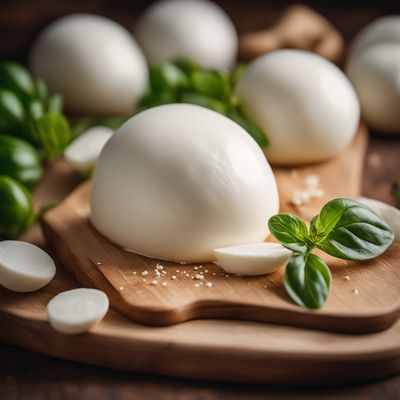
Ingredient
Cottage cheese
Creamy Curds: Exploring the Delights of Cottage Cheese
Cottage cheese is a fresh cheese made from the curds of cow's milk. It has a soft and crumbly texture with a mild, slightly tangy flavor. The curds are typically large and moist, giving the cheese a unique and appealing mouthfeel. Cottage cheese is available in different varieties, including low-fat and non-fat options, making it suitable for various dietary preferences.
Origins and history
Cottage cheese has a long history dating back to ancient times. It is believed to have originated in Eastern Europe, where it was traditionally made in small cottages or homes, hence the name "cottage cheese." Over time, it spread to other parts of Europe and eventually gained popularity in North America. Today, cottage cheese is enjoyed worldwide and is a common ingredient in many traditional dishes.
Nutritional information
Cottage cheese is a nutrient-dense food, rich in protein, calcium, and other essential nutrients. It is low in fat and calories, making it a healthy choice for those looking to maintain a balanced diet.
Allergens
Cottage cheese is a dairy product and may contain lactose, making it unsuitable for individuals with lactose intolerance or dairy allergies.
How to select
When selecting cottage cheese, look for containers that are tightly sealed and check the expiration date to ensure freshness. Opt for cottage cheese with a creamy and moist texture, avoiding any that appear dry or have an off-putting odor.
Storage recommendations
To maintain the freshness and quality of cottage cheese, store it in the refrigerator at temperatures below 40°F (4°C). Keep it tightly sealed to prevent moisture loss and avoid storing it near strong-smelling foods to prevent flavor absorption.
How to produce
Cottage cheese can be made at home by heating milk and adding an acid, such as lemon juice or vinegar, to curdle it. The curds are then separated from the whey and drained, resulting in homemade cottage cheese.
Preparation tips
Cottage cheese can be enjoyed on its own as a snack or used as a versatile ingredient in both sweet and savory dishes. It can be added to salads, used as a filling for stuffed vegetables, blended into smoothies, or incorporated into baked goods for added moisture and protein. To enhance the flavor, cottage cheese can be seasoned with herbs, spices, or a drizzle of honey.
Substitutions
Ricotta cheese can be used as a substitute for cottage cheese in most recipes, as it has a similar texture and mild flavor. Greek yogurt can also be used as a substitute for a creamier and tangier alternative.
Culinary uses
Cottage cheese is commonly used in salads, dips, spreads, and as a filling for dishes like lasagna or stuffed shells. It can also be used as a topping for pancakes or waffles, or blended into smoothies for added creaminess.
Availability
Cottage cheese is widely available in grocery stores and supermarkets worldwide, especially in regions where dairy products are commonly consumed.
More ingredients from this category » Browse all

Mozzarella
The Melting Delight

Cheese, chevre frais
Fresh and Tangy Goat's Cheese

Quark
Creamy Delight: Unveiling the Versatility of Quark

Cheese, boilie
Savory Delight: Boilie Cheese

Mascarpone
The Creamy Indulgence: Mascarpone

Cheese, burrata
Creamy Delight: The Melt-in-Your-Mouth Cheese

Clotted cream
The Creamy Indulgence

Cheese, urda
The Creamy Delight: Exploring the World of Urda Cheese

Cheese curd
Squeaky Cheese Delight

Cheese, crescenza
Creamy Delight: Unveiling the Allure of Crescenza Cheese

Cheese, triple creme
Decadent Delights: Exploring Triple Creme Cheese

Cream cheese
Velvety Delight: Exploring the World of Cream Cheese
Recipes using Cottage cheese » Browse all

Sudanese Cheese-Filled Pancakes
Savory Delights: Sudanese Cheese-Filled Pancakes with a South Sudanese Twist

Croatian Spinach and Cheese Strukli Soup
Creamy Delight: Croatian Spinach and Cheese Strukli Soup

Yorkshire Curd Tart
Creamy Delight: Yorkshire Curd Tart

Rajasthani Sfincione - Spiced Sicilian Pizza
Rajasthani Sfincione: A Fusion of Sicilian Flavors with Rajasthani Spices

Marubini with Bryndza Cheese Filling
Slovak Twist on Italian Marubini: Cheesy Delights from the Heart of Slovakia

Swedish Spinach and Cheese Pie
Nordic Delight: Savory Spinach and Cheese Pie

Nagoya-style Cheesy Miso Bread
Umami Delight: Nagoya-style Cheesy Miso Bread

Stäerzelen with Swiss Cheese and Mushroom Filling
Savory Swiss Delight: Stäerzelen with Cheesy Mushroom Filling

Mkhlovani - Georgian Cheese-Filled Bread
Savory Georgian Delight: Mkhlovani - A Cheese-Filled Bread Extravaganza

Belizean Easter Pizza
Savory Delight: Belizean Easter Pizza with a Tropical Twist

Solterito Salad
Andean Delight: Solterito Salad

Indo-style Soufflé
Spiced Delight: Indo-inspired Soufflé